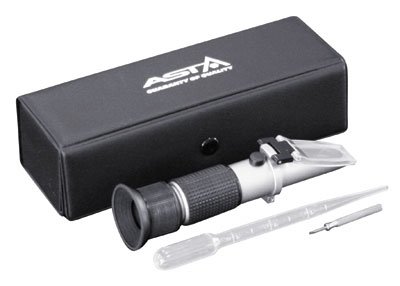A-HB2501
Warning: Invalid argument supplied for foreach() in /home/users/techman/public_html/www_astatools_tw/wp-content/themes/asta/partial/single-product_content.php on line 39
Refractometer
Device for testing liquid factors such as resistance to freezing the liquid in the cooling system in a car or the density of the electrolyte in the battery. Refractometer was made
of brass material, measurement scale is engraved, and the housing is made of aluminu, making it resistant to the weather conditions in which it is used. Set-Includes: Refractometer |
1 dropper | Screw drive for calibrating device. Elements: 1 – Prism | 2 – Cover | 3 – Calibration screw | 4 -Body | 5 – Eyepiece equipped with focus regulation ring. Scale: A- Temperature
scale for freezing of cooling fluid is scaled in from 0 to with a precision of It possesses two scales on the left side for propylene-based fluids and on the right side for
fluids based on ethylene, which are primarily use in Europe. | B – Temperate scale for freezing of windshield fluid scaled in゜C from with a precision of | C- Scale
of the density of the electrolyte, scaled inkg per liter (kg/l) between 1.1 and 1.4kg/l with a precision of 0.01 kg/l | 4 – Line of light / shadow indication readout. Calibration: The device is
calibrated for measurement at a temperature of Measurements may be made in the
temperature is not in order to calibrate, a dropper of distilled water should be used to place a droplet on the prism(1) and the instrument cover should be lowered(2). The screwdriver
included in the set should be used to calibrate the screw(3) until line of light/shadow coincides with the waterline. Measurement Procedure: 1 – Point the device towards bright light and
(5) set the focus by rotting the eyepiece. | 2 – Using the dropper included in the set, collect a small amout of the fluid to be meausred and place one or two drops on the prism (1), then lower the
cover (2) and press down lightly. | 3 – the line of light/shadow appears on the scale; this indicates the freezing temperature or density, depending on the fluid used. | 4 – Upon completion of the reading, the prism should be cleaned thoroughly using the cotton rag attached to the set. Note! Calibration and measurement should be conducted at the same temperature. If the temperature is changing
drastically, measurement should be completed once every 30 minutes. | Upon completion of measurement, the prism should not be cleaned with water, due to the possibility that the internal optics
of the device may sustain water damage. | Handle the device carefully. Avoid scratching the prism. Store in dry conditions which will prevent fogging of the optics. Protect the device from
concussions during transport. | Take special care in measuring the density of the electrolyte. Battery acid is a caustic substance. The dropper should always be used, and acid should not be
allowed to come into contact with the eyes or skin!

